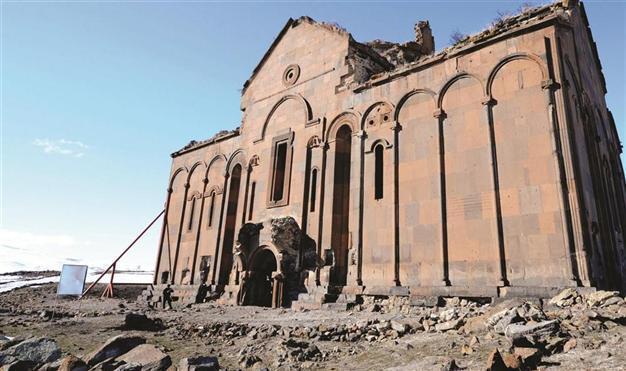City of Ani attracts more visitors
KARS - Anatolia News Agency

Dubbed ‘City of 1,001 Churches,’ Ani stood on various trade routes, and its many religious buildings and fortifications were among the most technically and artistically advanced structures in the world at the time, according to specialists. AA photo
Tourists are beating an evermore well-worn path to Ani, an ancient Armenian city in the eastern province of Kars that has long been regarded as one of Turkey’s most impressive tourist sites, according to newly released tourist numbers.Some 43,657 visitors went to the ancient city in 2012, a rise over the figure of 23,400 for the previous year. Close to a third of the visitors are from foreign countries, according to tourism officials.
Speaking to Anatolia news agency, Kars Culture and Tourism Manager Hakan Doğanay said there were a total of 21 main cultural treasures in Ani. “In fact, we call Ani an iceberg because we know there is a lot to discover and excavate at Ani.”
Experts know that Ani was a trade center in the past, said Doğanay, adding that the ancient city was a cultural mosaic. The cultural manager further said that if excavations were completed at the site, it could become one of the country’s leading tourism sites.
The planned excavation work will involve creating a detailed map of the site, which was once the center of a powerful Armenian empire and possessed a population of between 100,000 and 200,000 over a millennium ago, making it one of the biggest cities in the world at the time.
Ani was once the capital of a medieval Armenian kingdom that covered much of present-day Armenia and eastern Turkey. Ani is protected on its eastern side by a ravine formed by the Akhurian River and on its western side by the Bostanlar or Tzaghkotzadzor Balley. The Akhurian is a branch of the Aras River and forms part of the current border between Turkey and Armenia.
City of churches
Dubbed the “City of 1,001 Churches,” Ani stood on various trade routes, and its many religious buildings, palaces, and fortifications were among the most technically and artistically advanced structures in the world at the time, according to specialists.
The site occupied 78 hectares of land and was surrounded by 4,500-meter-long ramparts. In addition to its numerous churches, the site also features the remains of an inn, a public bath, one of the first mosques in Anatolia and other buildings. The site was located on the historic Silk Road and formed the first gate connecting the Caucasus to Anatolia before a sea route was discovered. “[The city] declined in importance after [sea routes gained prominence]. And it was destroyed by periodic earthquakes. Between 1965 and 1966, a professor named Kemal Balkan launched the first excavation work on the Ani ruins. Then between 1989 and 2005, excavation and cleaning works were done. Between 2005 and 2009, the excavation work was halted,” Doğanay said. Ani was placed on the World Cultural Heritage List thanks to an application by the Culture and Tourism Ministry, he said, adding that it was an integral part of the region. “Ani is a city of universal religions. We call it a world city since people from all nations, cultures, and races live there,” he said. “It is essential to bring this world city to light and give it to the world as soon as possible. Our work is ongoing in a planned and systematic way.”
















